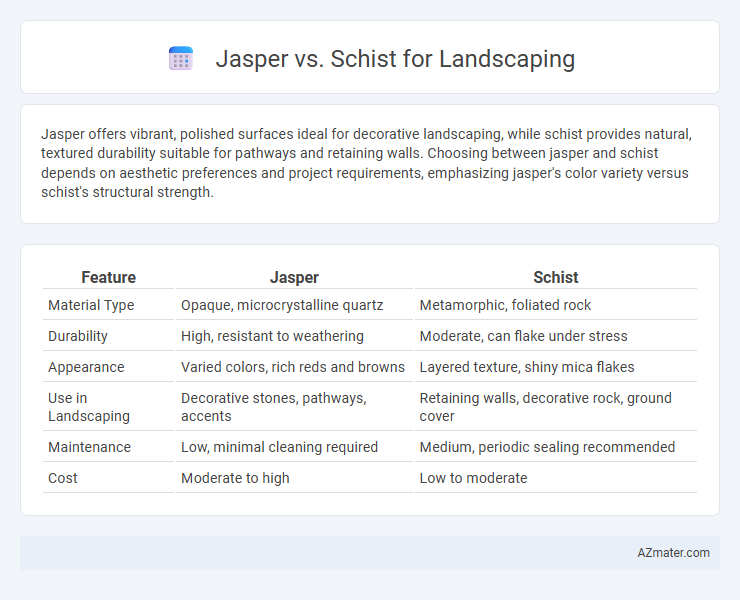Jasper offers vibrant, polished surfaces ideal for decorative landscaping, while schist provides natural, textured durability suitable for pathways and retaining walls. Choosing between jasper and schist depends on aesthetic preferences and project requirements, emphasizing jasper's color variety versus schist's structural strength.
Table of Comparison
| Feature | Jasper | Schist |
|---|---|---|
| Material Type | Opaque, microcrystalline quartz | Metamorphic, foliated rock |
| Durability | High, resistant to weathering | Moderate, can flake under stress |
| Appearance | Varied colors, rich reds and browns | Layered texture, shiny mica flakes |
| Use in Landscaping | Decorative stones, pathways, accents | Retaining walls, decorative rock, ground cover |
| Maintenance | Low, minimal cleaning required | Medium, periodic sealing recommended |
| Cost | Moderate to high | Low to moderate |
Introduction to Jasper and Schist in Landscaping
Jasper, a vibrant and dense form of chalcedony, is prized in landscaping for its rich colors and durability, making it ideal for decorative stones and accent features. Schist, a foliated metamorphic rock with distinctive layers and a natural sheen, offers excellent versatility and texture in garden paths, retaining walls, and rock gardens. Both materials enhance outdoor aesthetics but differ in hardness and visual appeal, influencing their specific landscaping applications.
Geological Formation and Characteristics
Jasper and schist differ significantly in geological formation, with jasper forming as a microcrystalline variety of quartz through sedimentary processes, resulting in its hardness and vibrant, often multicolored appearance. Schist is a metamorphic rock characterized by its foliated texture, formed under intense heat and pressure that realigns its mineral grains, making it more pliable and layered compared to jasper. In landscaping, jasper's durability and striking patterns are ideal for decorative features, while schist's flaky structure contributes to naturalistic ground covers and retaining walls.
Visual Appeal: Color and Texture Comparison
Jasper offers a rich palette of deep reds, yellows, and browns with a smooth, polished texture that adds vibrant, earthy warmth to landscaping projects. Schist features a layered, flaky texture with metallic sheens and varying shades of gray, green, and brown, providing a rustic, natural aesthetic ideal for textured accents in gardens. The choice between Jasper and Schist centers on whether a bold, glossy color or subtle, rugged texture best complements the landscape design.
Durability and Weather Resistance
Jasper offers superior durability and weather resistance compared to schist, making it ideal for landscaping projects exposed to harsh environmental conditions. Its dense, hard composition resists cracking, fading, and erosion from freeze-thaw cycles better than the softer, foliated structure of schist. In outdoor settings, jasper maintains its integrity and vibrant colors over time, while schist is more prone to flaking and weather-related deterioration.
Installation and Maintenance Requirements
Jasper requires careful installation due to its hardness and weight, often needing professional tools and expertise to cut and set properly in landscaping projects. Schist, being a foliated metamorphic rock, offers easier installation thanks to its natural cleft surfaces that split into thin, manageable layers, reducing labor time and costs. Maintenance for jasper involves periodic sealing to preserve its vibrant colors and prevent staining, while schist demands regular inspection for flaking and occasional cleaning to maintain its textured appearance.
Cost Factors and Availability
Jasper is typically more expensive than schist due to its rarity and aesthetic appeal in landscaping projects. Schist is widely available and often sourced locally, which reduces transportation costs and makes it a budget-friendly option. Cost factors for both stones include quarrying, processing, and regional availability, with schist generally providing a more economical choice for large-scale landscaping.
Environmental Impact and Sustainability
Jasper and schist differ significantly in environmental impact and sustainability for landscaping; jasper, a form of opaque quartz, is non-porous and durable, reducing erosion and requiring less maintenance or chemical treatment. Schist, a foliated metamorphic rock, is often more abundant and locally sourced, minimizing transportation emissions but may weather faster, potentially increasing long-term resource use for replacement. Choosing jasper prioritizes longevity and low chemical input, while schist supports local economy and lower carbon footprint through reduced transport.
Best Landscaping Applications for Jasper
Jasper is ideal for landscaping applications that require vibrant color and durability, such as decorative garden pathways, accent stones, and water features, due to its rich red, yellow, and green hues and hardness. Unlike schist, which often flakes and weathers over time because of its foliated texture, jasper maintains a polished look and resists erosion, making it suitable for high-traffic areas. Jasper's ability to enhance aesthetic appeal while providing long-lasting structural integrity makes it the preferred choice for ornamental and functional landscape designs.
Optimal Uses of Schist in Landscaping
Schist is highly valued in landscaping for its natural layering and rich texture, making it ideal for decorative rock walls, garden pathways, and retaining walls that require both durability and aesthetic appeal. Its foliated structure allows for easy splitting into flat slabs, perfect for creating natural-looking patios or stepping stones that blend seamlessly into outdoor environments. Schist's resistance to weathering and its earthy color palette optimize its use in sustainable, low-maintenance landscape designs that emphasize rugged elegance.
Jasper vs Schist: Which is Right for Your Project?
Jasper offers vibrant, rich colors and a polished finish that enhances decorative landscaping elements, while schist provides a natural, textured appearance ideal for pathways and retaining walls due to its durability and layered structure. The choice between jasper and schist depends on the desired aesthetic and functional requirements of your project, with jasper excelling in ornamental features and schist favored for structural support and rustic designs. Evaluating factors such as weather resistance, maintenance needs, and visual impact ensures selecting the appropriate stone for long-lasting, visually appealing landscaping.

Infographic: Jasper vs Schist for Landscaping
 azmater.com
azmater.com